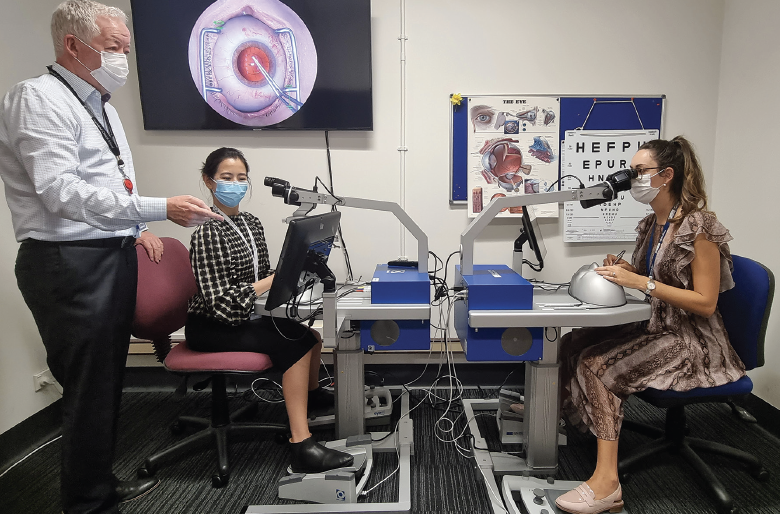COVID-19 Continues to Affect Medical Education
Rosa Giglio, MD; Alex Lucia Vinciguerra, MD; and Daniele Tognetto, MD
Italy



The SARS-CoV-2 outbreak and subsequent lockdown measures have significantly affected the way that health care providers work and learn. Because of social distancing requirements, most scientific meetings have been cancelled since March 2020. Online educational programs such as webinars, virtual meetings, learning labs, and lectures have been arranged by eye care professionals throughout the world to keep residents and ophthalmologists up to date on skills and knowledge. In our experience, virtual platforms offer a unique way for us to communicate, collaborate, and interact with colleagues from anywhere in the world without having to travel.
We have all had to seek alternative ways to obtain continuing medical education (CME) for ourselves, and we have used many different learning plans to update colleagues on recent innovations. Online video platforms such as Zoom, Skype, and Microsoft Teams provide a click-and-connect solution to the conferencing dilemma. These and other platforms allow us to collaborate, share our work, and even attend virtual conferences. Digital solutions, however, lack many of the benefits of in-person conferences such as dinner conversations and face-to-face networking. On a positive note, they provide an alternative opportunity to stay up to date when physical gatherings are not possible or are inconvenient.
Currently, many ophthalmologists look to distance/online learning solutions to obtain CME. This resource is easily accessible for learning about recent innovations and improving personal skills. Some specific telematic electronic-learning, or e-learning, platforms also allow interaction in real time. New opportunities include web-based case presentations and journal clubs, webcasts, and online national and international webinars. The pandemic therefore does not appear to have significantly limited the acquisition of theoretical knowledge. Ophthalmologists from all over the world continue to hold discussions and learn simultaneously but in a virtual format.
Increased use of virtual teaching methods and online courses, training, and conferences are one effect of the pandemic that will likely remain in place for the foreseeable future. We believe, however, that it is worth reflecting on prepandemic teaching methods and considering the effectiveness of e-learning and its impact on shaping future methods of specialization training. This exercise may help us decide if a return to conventional training methods once the pandemic is over is desirable or if virtual teaching should be included permanently in educational programming.
The implications of social isolation have strengthened our spirit of adaptation. Albeit unconsciously, we have adapted to the COVID-19 era and will emerge from this crisis stronger than before. It is reasonable to think that we will continue to rely on remote learning and digital innovation for years to come.
The Perspective of an ‘Elbows-Only’ Girl
Nadia Haqqie, MD
United States

Gone are the conferences we remember—sitting in a crowded auditorium listening to the experts in ophthalmology share their knowledge and skills and letting loose afterward while packed into some bar or club for the Cornea Society party. Thanks to modern technology, we can watch a lecture from the back of a symposium hall on a large monitor, or we can tune in from the comfort of our couch while cuddled up next to our dogs and enjoying a cup of tea.
The ASCRS and AAO have pivoted nicely since the onset of the pandemic. Both organizations offer more CME opportunities now than ever before and highlight them on their homepages with CME tabs and links to myriad short courses for self-paced learning. For many of us, on-demand educational opportunities offer a way to fit learning into our hectic schedules.
I fulfilled the bulk of my CME credits in 2021 by attending the annual ASCRS and AAO meetings in person. AAO did an outstanding job of helping attendees feel safe and protected at the convention center by requiring proof of vaccination and offering color-coded stickers to be placed on lapels or badges to indicate the wearer’s comfort level with physical contact and proximity to others—green for handshakes and high-fives, yellow for bumping elbows, and red for no physical contact. (For the record, I am currently an “elbows-only” type of girl.)
I stayed in New Orleans for only part of the AAO conference owing to my clinic and OR schedules, but I was able to tune in remotely, both in real time and on demand, from the airport and at home. I like to go through the conference schedule in advance and make a list of all the topics that pique my interest. I feel this helps maximize my learning opportunities and minimize the chance that I will miss a session I want to attend.
I also obtain 8 CME credits per year by completing the American Board of Ophthalmology’s Quarterly Questions program. Other great resources for CME credits include MedEdicus and Healio. Both free sites have a wealth of case-based, self-paced learning programs. (Full disclosure, I’ve even sneaked in a few of these cases in between patients on slow clinic days.)
But what kind of faculty member would I be if I didn’t gently plug the Wills Eye Hospital Knowledge portal? This platform lists upcoming and past conferences available for viewing on demand.
Lastly, CME opportunities pop up on my radar via social media, which helps me stay informed and connected to ophthalmologists at all stages of their careers. Doctors have so much to learn from each other, and connecting is now easier than ever.
I frequently find myself registering for events through Instagram. I take advantage of virtual programs whenever possible. I like sitting at home and learning in my pajamas. I don’t imagine that will change any time soon.
New Zealand-Aotearoa: Thoughts From the South Pacific
Charles N.J. McGhee, MB, PhD, DSc, FRCS, FRANZCO, FRCOphth
New Zealand

The COVID-19 global pandemic, which few might have predicted in 2019, has created international chaos and caused millions of deaths over the past 2 years. CME has been hampered significantly by the increased clinical burden on physicians and health care providers. Unfortunately, it is likely that eye care will be affected for the next 2 to 3 years at least.
Located in the South Pacific, New Zealand-Aotearoa has been spared some of the severity of the volume of COVID-19 cases experienced in the United States, Europe, and Asia thanks to our country’s geographic isolation and proactive government. Nonetheless, the impact of COVID-19 on daily life, health care, and the economy is severe. As I write this, we are coming out of 3 months of enforced lockdown—and this is with a 90% vaccinated population.
The clear and immediate impact on CME has been the loss of in-person conferences. There have been only three national congresses with more than 100 individuals in attendance in the past 2 years. Larger conferences such as Asia-Pacific Academy of Ophthalmology and The Royal Australian and New Zealand College of Ophthalmologists (RANZCO) were cancelled or held virtually. Overseas travel has been impossible because of travel bans and the requirement for 2 weeks of quarantine after the return home.
I typically attend five or six international conferences per year. I enjoy hearing the latest educational updates and, equally important, engaging in stimulating dialogue with colleagues. In the absence of international travel, I have attended as many local conferences and small specialist group meetings as possible. A more broad-based approach to CME has been necessary, however, including the incorporation of virtual conferences, online courses and webinars, and self-directed work. Online virtual conferences have blossomed, and their quality has improved in the past 2 years. Real-time and on-demand educational content is the main source of most ophthalmologists’ current CME activities.
Our profession is driven by the highest clinical standards and considerable attention to detail. One aspect of CME that has been easy to pursue during the current pandemic is a detailed audit. During the past 2 years, I have conducted several audits on the risk stratification of cataract surgery, outcomes of toric IOLs in eyes with a history of keratoplasty, and outcomes and survival rates of eyes after lamellar keratoplasty. These audits have provided useful clinical data and publishable material, and they have allowed me to acquire necessary CME credits.
I find that the RANZCO’s Continuing Professional Development guidelines for Ophthalmologists1 are widely applicable. Notably, clinical audits and peer review may be conducted with colleagues online via video conferencing rather than in person, as required previously. Regarding auditing, in-depth medicolegal reports, which require precision and careful referencing, are a popular practice. The review of office records, a less time-consuming auditing tactic, may also be used. In this practice, five to 10 cases of a specific disease state are reviewed by using one of the templates available on the RANZCO website.
Those who practice in teaching hospitals can obtain CME through the teaching and mentoring of trainees, either in person or virtually (Figure). Virtual lectures offer slightly less freedom of expression, but they demand more precision in presentation and greater slide detail. In my practice, we have updated all under- and postgraduate lectures to an online format over the past 2 years. This has required considerable review of existing evidence.

Figure. Dr. McGhee mentors residents on the EyeSi virtual reality surgical suite during COVID-19 restrictions.
Courtesy of Charles N.J. McGhee, MB, PhD, DSc, FRCS, FRANZCO, FRCOphth
Finally, in my own clinical academic practice, I have used time during lockdowns to conduct intensive clinical research, attend virtual meetings with registrars and doctoral students, develop and push projects to the manuscript submission stage, and provide significant CME activity for many health care professionals.
I believe the diversity of CME activities is key to keeping the old grey cells active during this psychologically draining period in history. I look forward to warm interactions with colleagues at physical conferences in 2022.
1. Continuing professional development. The Royal Australian and New Zealand College of Ophthalmologists. December 17, 2021. Accessed January 26, 2022. https://ranzco.edu/home/ophthalmologists/membership-and-cpd/continuing-professional-development/




